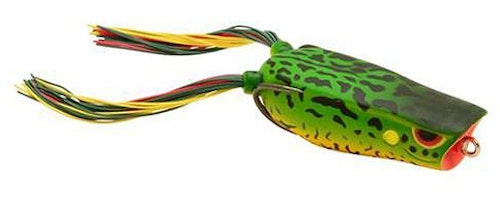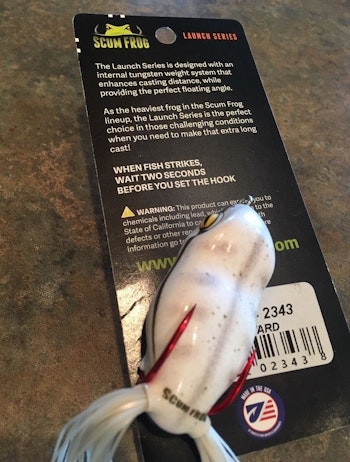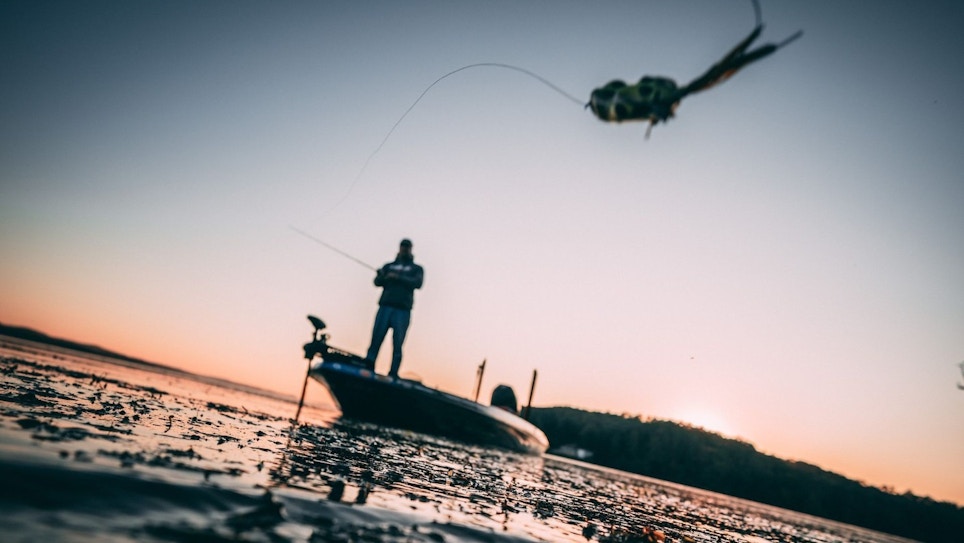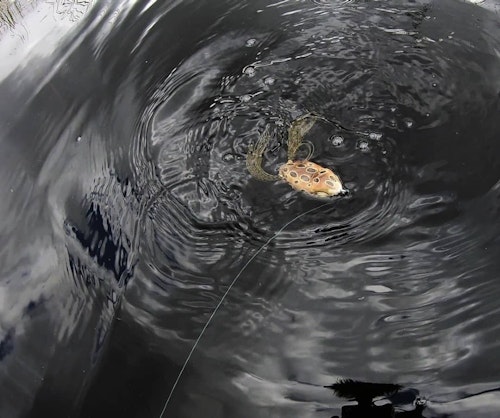After bass have spawned and spring turns to summer, many lakes are blanketed by matted vegetation. Under the right conditions, hungry bass patrol these areas looking for an easy meal.
Because of the heavy cover, it’s difficult to present lures to bass in an efficient manner. Sure, you can adopt a snail’s pace approach and punch through the heavy cover with a Texas-rigged creature or a weedless jig. This is a great way to catch largemouth bass, especially when they’re in a neutral or negative mood. However, when bass are aggressive, it’s often a smarter game plan to cover more water, and during summer there’s no better way to accomplish this task than with a hollow-bodied frog.
If you’re new to bass fishing in heavy cover, or had trouble hooking and landing bass with hollow-bodied frogs in the past, then the following three tips will increase your success dramatically.

1. Use the Correct Tools.
Your choice in rod, reel and line isn’t always critical when bass fishing. For example, you can catch bass on spinnerbaits and vibrating jigs (like Chatterbaits) with any medium- or medium-heavy power, fast-action baitcasting rod matched with a decent reel and at least 14-pound-test line. Speed ratio on the reel isn’t critical. Want to use heavier line? Fine. As long as you can keep the lure moving and set the hook with a bit of force, you’ll hook and land plenty of bass.
This is not the case when frog fishing in heavy cover. If you bring this same medium-power baitcaster matched with 14-pound line to the matted jungle and expect it to work okay with a hollow-bodied frog, then prepare to be disappointed.
Sure, this rod/reel/line setup will cast the frog just fine. And you can even work the frog well enough to entice strikes. But unless you’re satisfied with watching blowups and losing almost every fish, it’s better to use the correct tools.
Rods are most important. My two favorites are the G.Loomis 7-foot 4-inch IMX-PRO 885C TWFR Topwater Frog Rod (mag heavy power, fast action) and St. Croix 7-foot 4-inch Victory VTC74HF (heavy power, fast action). Both models have the muscle to set the hook and then winch bass out of the junk. They also have just enough tip action for easy and accurate casting of lightweight hollow-bodied frogs.
For frog fishing, a high-speed reel isn’t mandatory. My favorite is a Shimano Curado 200K (model CU200K), which has a 6.2:1 gear ratio. It allows me to make long casts without backlashing, and the drag is superb.
Line choice is critical; this lure presentation requires no-stretch braid. I like 50-pound-test Power Pro Maxcuatro (moss green color) because it’s thin, casts a mile, and is super tough. You need the strong line to winch a big bass from heavy cover even if it’s tangled in lily pad stems or other cover. More on that later.
2. Use a Top-Notch Frog
Not all hollow-bodied frogs are created equal. You want one that is heavy enough for easy and long casting, one that comes through matted vegetation without gathering weeds on the hooks, one that hooks fish well, and one that is durable — at approximately $10 each, you want to catch a lot of bass on a single frog before it’s trashed.
Of all the desirable attributes I’ve listed here for a hollow-bodied frog, the one that separates the best from the rest is “one that hooks fish well.” A top-notch frog has a soft body that compresses easily when a bass inhales it. If it’s too soft, however, it’s likely made with too light of rubber and won’t cast well, it will gather too many weeds during the retrieve, and it won’t be durable. The key is finding a soft frog that’s still heavy enough to cast well, is 100 percent weedless, and tough. And it must have large, sticky-sharp double hooks.
My three go-to frogs are the Jackall Kaera, SPRO Bronzeye Pop 60 and Scum Frog Launch Frog. In murky water, especially when weeds don’t form a complete blanket, I like the added attraction provided by a popping frog (like the Pop 60). I can fish it slow and make more noise with it than a standard frog. When weeds are matted and I want to cover more territory, then I go with a standard-shaped hollow-bodied frog such as the Kaera or Launch Frog.




3. Pause. Hit ‘em hard. Start cranking!
If you hit the jungle with the correct rod/reel/line combo, and a top-notch frog, then you’re on your way to hooking a higher percentage of fish. What separates the frog whisperers from the frog wannabes is technique. For example, my 18-year-old son Elliott is crazy good when it comes to hooking and landing bass on frogs. And whenever I fail to hook a bass, or it gets off during the fight, he’s quick to point out my shortcomings.
Make a long cast over likely bass-holding cover and then retrieve your frog in a cadence that causes it to scoot across the surface in short, rhythmic pulses. Keep your rod tip low to the water, pointed toward the frog. I keep the frog moving continuously over matted cover, but sometimes I’ll pause it in and around open pockets in the vegetation. There’s no single right way to work a frog. (FYI: YouTube is filled with frog fishing videos, so spend some time watching a few if you’ve never retrieved a frog. I recommend checking out the guys at Tactical Bassin; they have an entire playlist on frog fishing; check it out by clicking here.)
The biggest mistake beginner frog fishermen make is setting the hook too fast. When a bass strikes your frog, stop moving the rod tip. Don’t set the hook immediately. You want to give the bass about one second to inhale the frog and swim back under the surface. As the bass is swimming with your frog in its mouth, you should be quickly winding up slack line and getting ready to set the hook. Again, your rod tip is low and you haven’t moved it since the strike. Say “one thousand one” out loud if it helps you train your body to get the timing right.
After one second of winding slack line without moving the rod, set the hook as hard as you can by quickly raising your rod up and to the right (for right-handers). If the bass has your lure, your rod should be loaded. Keep it loaded and begin winching the bass to you. Don’t lower your rod toward the fish because that will put a bit of slack in the line and you’ll likely lose the fish. Keep your rod tip high, keep a bend in the rod and crank the reel handle as best you can. This is a tug-o-war between you and the fish.
Done correctly, you should drag small bass (say 2.5 pounds and less) across the surface and to the boat. With the correct gear, it’s not a fair fight. Period. That said, with bigger bass, and especially those weighing 4 pounds or more, you’ll have all you can handle to winch the fish to the boat. Do your best to keep the bass on the surface, and keep working — keep winching.

Don’t be surprised if you bring up a garden of vegetation with your fish (above). It might be difficult to identify what’s on the end of your line, so be careful reaching into the matted clump. You don’t want a hook in your hand. Many times I reach down and pull some weeds of the line to see what’s going on and then make my move to grab the fish by the mouth.
Note: A landing net with fish-friendly netting works well for frog fishing. Simply scoop the entire jungle and then sort it all out boat side and you don’t have to risk losing a fish.








